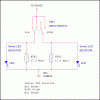Hi, I'm new to this site and hoping to get some help on a project. I'm working on installing something (heated grips) on a motorcycle that uses a 3 way toggle switch (for off, hi, low) and I am trying to add a single LED to illuminate when the switch is on (either hi or low). I know enough to know that connecting leads from the switch output prongs to a single LED will connect the two separate hi and low circuits together and believe I need to insert diodes on each leg in order to isolate the two circuits.
So I've run a wire from each switch output post (hi and low), each through separate diodes (a very small item from radio shack but unfortunately I tossed the packaging so not sure on specific model) and then connected the cathode side (black stripe) of the two diodes together to the LED annode, then grounded the cathode leg of the LED (forgive me if I've butchered terms, but think i got that all right).
So I hoped this would result in the lo side staying off when the hi side is switched on, and vice versa, but both would illuminate the LED. No such luck. The LED lights, but 12v is passing through both legs of the switch (i.e., when switched to hi, the low side is also getting 12v through the diodes circuit (despite the diodes).
So have I misunderstood how diodes are supposed to work? Is this the right approach but I've just got the wrong diode perhaps? The max draw on the main Hi side circuit is 35w but I would think much less than that would be pulled through the diodes/LED circuit as it is a dedicated circuit. I've seen some diodes with three prongs and wonder if these are effectively two diodes in one package that might work for my application.
Thanks so much for any help here.
So I've run a wire from each switch output post (hi and low), each through separate diodes (a very small item from radio shack but unfortunately I tossed the packaging so not sure on specific model) and then connected the cathode side (black stripe) of the two diodes together to the LED annode, then grounded the cathode leg of the LED (forgive me if I've butchered terms, but think i got that all right).
So I hoped this would result in the lo side staying off when the hi side is switched on, and vice versa, but both would illuminate the LED. No such luck. The LED lights, but 12v is passing through both legs of the switch (i.e., when switched to hi, the low side is also getting 12v through the diodes circuit (despite the diodes).
So have I misunderstood how diodes are supposed to work? Is this the right approach but I've just got the wrong diode perhaps? The max draw on the main Hi side circuit is 35w but I would think much less than that would be pulled through the diodes/LED circuit as it is a dedicated circuit. I've seen some diodes with three prongs and wonder if these are effectively two diodes in one package that might work for my application.
Thanks so much for any help here.


